- Home
- Deborah Harkness
The World of All Souls Page 23
The World of All Souls Read online
Page 23
See also:
CREATURES: Vampires
CHARACTERS: Rudolf II
DECORATIVE ARTS: Decorative Chain with Dragon Pendant
Oxford University
The ancient university of Oxford, with its dreaming spires, Gothic architecture, medieval passageways, and revered traditions, is the ideal setting for a historian witch to meet a fifteen-hundred-year-old vampire geneticist.
There is no specific date for Oxford’s founding, but there are records of teaching existing in some form there in 1096. Following Henry II’s ban on English students attending the University of Paris in 1167, this evolved rapidly. By 1201 the scholars were headed by a magister scolarum Oxonie, with the title of chancellor conferred on him in 1214, and in 1231 the masters were recognized as a universitas (or corporation). The university was granted a royal charter in 1248, under King Henry III.
There has been rivalry, sometimes violent, between the townspeople and scholars since the university’s earliest incarnation. Friction and riots during the thirteenth century, with students living all over the city, led to the establishment of medieval halls of residence. These were largely monastic institutions and were gradually taken over by the colleges. Later, they were dissolved during Henry VIII’s Reformation in the sixteenth century due to their association with the Catholic Church. St. Edmund Hall, now a college, is the last surviving hall that links continuously back to these early establishments. Merton, University, and Balliol were the first official colleges, founded between 1249 and 1264, and as others followed, Oxford quickly flourished. Within a hundred years, it was recognized as a key center of scholarship, revered by powerful voices in Europe and praised by Edward III of England in 1355 for its contribution to learning.
The university has continued evolving and adapting over the centuries, through political and religious upheaval as well as social and scientific revolution. Halls were finally established for women from 1878, and the male colleges began to admit women starting in the 1970s. Today there are thirty-eight colleges, all self-governing organizations within the university and all admitting both men and women, including Diana’s New College and Matthew’s All Souls College.
Bodleian Library and Duke Humfrey’s
I drew the library’s familiar air into my lungs and shut my eyes, hoping that would bring clarity. The Bodleian had always been a sanctuary to me, a place unassociated with the Bishops.
The Bodleian Library is one of the world’s greatest treasures. You don’t need to be a witch to feel the magic and history in its atmospheric buildings and reading rooms, unlocking the past, as Diana does, through its vast collection of books and manuscripts.
The Bodleian, also known as Bodley or the Bod, was refounded as Oxford University’s central library by Sir Thomas Bodley and officially opened on November 8, 1602. Bodley, born in 1545, spent much of his childhood in Europe, escaping the persecution of Protestants in England under Queen Mary. When he and his family eventually returned, he studied at Oxford and was accepted as a fellow of Merton College. He went on to work as a diplomat at Queen Elizabeth I’s court and married a wealthy widow. After retiring from royal service Bodley turned his attention back to Oxford and decided that he would “set up my staff at the library door in Oxon; being thoroughly persuaded, that in my solitude, and surcease from the Commonwealth affairs, I could not busy myself to better purpose, than by reducing that place (which then in every part lay ruined and in waste) to the public use of students.”*
The university’s first known central library was founded in the early fourteenth century, a small hoard of books housed in the University Church of St. Mary the Virgin on the High Street. As this collection expanded, a new, bigger library, called Duke Humfrey’s, was built (completed in 1488) above the Divinity School. Named after Humphrey of Lancaster, the 1st Duke of Gloucester and younger son of Henry IV of England, Duke Humfrey’s was originally built to house the 281 manuscripts he donated to Oxford on his death in 1447. Sadly, only three of Humphrey’s original manuscripts remain in the Bodleian. The library was stripped of books and furniture during the 1550s and lay abandoned until Bodley’s intervention. When you step inside Duke Humfrey’s today, it is easy to understand its reputation as one of the most beautiful university libraries in the world.
Having saved and reestablished the university library, Bodley’s clever innovations in the running of it secured the Bodleian’s growth and high status. He struck a deal with London’s printing guild, the Stationers’ Company, which ensured that a copy of every book published in England and registered at Stationers’ Hall would be deposited at the Bodleian. These were to be securely housed and never circulated to borrowers. Not even King Charles I could convince the librarians to break this rule.
Another tradition that Bodley introduced in 1602 was the Benefactors’ Book. This was displayed prominently in the library so all visitors could see those friends who had generously donated to the Bodleian’s collection. Though Bodley was wealthy, he knew that the ongoing success of the library would rely on the contributions of his contacts and friends. As he hoped, the donations came steadily in, for “every man bethinks himself how by some good book or other he may be written in the scroll of the benefactors.” One such celebrated benefactor, whose statue Diana walked past in the quadrangle every day on her way to the library, was William Herbert, 3rd Earl of Pembroke (chancellor of Oxford University from 1617 to 1630) and beloved son of her friend Mary Sidney.
As the collection grew quickly from generous donations, it was soon clear the Bodleian needed more space. In 1610–12 Bodley financed the first extension to the medieval Duke Humfrey’s library. Soon after Bodley’s death in 1613, work started on the Schools Quadrangle and was largely completed by 1619. Today Duke Humfrey’s consists of the original medieval section in the middle, with the east wing known as the Arts End added in 1612 and the west wing, the Selden End (named after another benefactor, John Selden), added in 1637.
The Bodleian has continued expanding through the centuries to a collection that now numbers more than 12 million items, housed in various locations, boasting an extraordinary array of rare manuscripts and copies of early printed books. With such an extensive collection, it is inevitable that some items could be mixed up or labeled incorrectly, waiting to be called up by an unsuspecting scholar. Ashmole 782 may be one of them.
See also: LITERATURE: Ashmole 782
All Souls College
Matthew Clairmont’s college is, not surprisingly, the most mysterious, elite, and difficult to penetrate of all the Oxford colleges. It is closed to undergraduates, and, uniquely, all those who manage to pass the notoriously challenging entry exam automatically become fellows and full members of its governing body. The “College of the souls of all the faithful departed,” more commonly known as All Souls, was given its foundation charter in 1438 by King Henry VI of England and established by Henry Chichele, archbishop of Canterbury. Like the other colleges, All Souls originally had a clear religious role, with the forty fellows required to take holy orders and attend chapel to pray for those who had died in the Hundred Years’ War, as well as the college’s founders. Those who were admitted had to have studied somewhere else for at least three years previously, with the original statute specifying there were to be twenty-four artist (theology) and sixteen jurist (law) fellows.
Today All Souls is largely a graduate research institution covering a wide range of studies. It accepted its first female fellow in 1981. It did once have a small number of undergraduate members, first admitted during the seventeenth century. But it is recorded that the warden at the time, Richard Hovenden, permitted their entry only to provide fellows with “servientes,” and this practice was abandoned in the nineteenth century.
One of All Souls’ more unusual traditions takes place once every hundred years. The ceremony, which dates back to the establishment of the college, requires the fellows of All Souls to parade around t
he college grounds with flaming torches, singing a song while hunting down a giant mallard that is said to have flown out of the college’s foundations when it was first being built. The procession is presided over by a fellow dressed as Lord Mallard and led by another fellow holding up a wooden duck tied to a pole. (A dead duck was used in the past.) The last Mallard ceremony was held in 2001, so the next will not take place until 2101. The Mallard song, however, is sung annually at college gaudies (feasts and celebrations).
All Souls is one of the wealthiest Oxford colleges and, as Diana discovered when Matthew took her down into the depths of its wine cellars, holds one of the finest collections of rare vintages in England. The buildings that overlook the High Street show how the medieval college would have looked, but it is the refurbished North Quadrangle that is All Souls’ most striking feature. Designed by Nicholas Hawksmoor in the eighteenth century, the quadrangle includes the Codrington Library (named after benefactor Christopher Codrington), and a grand dormitory of fellows’ rooms running down the eastern side, with Hawksmoor’s Gothic towers majestically facing the Radcliffe Camera Square.
New College
The founder of All Souls, Henry Chichele, was originally a member of Diana’s college. New College was founded in 1379 by William of Wykeham, and called the College of St. Mary of Winchester in Oxford. As there was already another college dedicated to the Virgin Mary (Oriel, where Sir Walter Raleigh studied), it became known as New College—something of a misnomer given it is one of the university’s oldest foundations. William of Wykeham, bishop of Winchester and high chancellor of England, bought land in Oxford, on what had reportedly been the city ditch (and used to bury the dead during the Black Death), and obtained a charter from King Richard II to establish a college there in conjunction with his opening of a school, Winchester College. Wykeham planned that boys from this school would go on to his new Oxford college, and the statutes specified that all fellows had to have studied at Winchester first. Both these institutions were set up for the education of priests, who were in shorter supply after the ravages of the Black Death.
New College adopted William of Wykeham’s motto, “Manners Makyth Man.” As someone who had climbed from a modest rural background to high office in King Edward III’s court, dying in 1404 one of the richest, most influential men in England, Wykeham promoted the idea that status was bestowed not by birth or entitlement but by the way in which a person behaved (fairly radical for the time).
Nineteenth-century reforms in the college swept away most of the old medieval statutes, breaking the monopoly that Wykehamists (Winchester College boys) had always held and widening the areas of study. Women were accepted as undergraduates in 1979. One thing that has remained constant, however, is New College’s choral tradition. Its choir has a reputation as one of the finest in the world and is in demand for recordings and concert appearances on top of its obligations in the college church services.
Another tradition going back to the first foundation of the college is the lord mayor of Oxford’s ceremonious inspection, every three years, of the city wall that backs onto the college’s unique medieval gardens. When Wykeham was granted the land, it was on condition that the college agree to maintain the ancient walls for the defense of the city, and that promise is carefully monitored to this day. The college’s front quadrangle, chapel, dining hall, and cloisters, in which Diana sought refuge after being threatened by Peter Knox, were all built within a few years of the college’s foundation, with additions and refurbishments made throughout the centuries. Some of the stained-glass windows in the impressive chapel were replaced in the eighteenth century, the new ones designed by Sir Joshua Reynolds: the same portraitist who captured Philippe and Ysabeau so strikingly in the painting Unknown Married Couple.
See also:
CHARACTERS: Diana Bishop, Matthew de Clermont
LOCATIONS: Oxford
DECORATIVE ARTS: Paintings
LIFESTYLE: Rowing
Yale University
Yale University was founded in 1701 as the Collegiate School, in what is now the town of Clinton, Connecticut. Its aim was to train ministers and lay leadership for the church. The college moved to Saybrook and Wethersfield, then made its permanent home in New Haven in 1716. When a new building was needed two years later, Cotton Mather, the leading clergyman in New England, convinced the wealthy Elihu Yale to donate a substantial sum for its construction. To show their gratitude, college officials named the building Yale, and later the entire institution became known as Yale College. (Cotton Mather, incidentally, was also well known for his support of the 1692 Salem Witch Trials.)
In 1714 Yale received a donation of about seven hundred books from England, representing the best of the period’s literature, science, philosophy, and theology. Almost overnight Yale had one of the largest book collections in New England.
Over the centuries Yale College expanded its curriculum beyond theology to medicine, biology, behavioral sciences, law, and music, and in 1887 it was renamed Yale University. The evolution of the admissions policy was slower, however. Women were included in some graduate-level programs as early as 1892 but were not admitted as undergraduates until 1969. And Yale professor Chris Roberts would be quick to add that Yale was among the last of the Ivy League schools to eliminate tacit quotas that favored white Protestants from notable families.
Yale was a natural choice for Diana Bishop, who had fallen in love with all things English (including tea!) while doing summer study as an undergraduate at Oxford. After graduation she returned to Oxford to pursue a doctorate in the history of science, focusing on the age when astrology and witch-hunts yielded to Newton and universal laws. She then set her sights on a position at Yale, “the only place that was more English than England.” Besides representing the English influence that she loved and a solid reputation for scholarship, Yale offered the Beinecke Rare Book & Manuscript Library.
Beinecke Library
Much of the Yale campus looks like it was built in the Middle Ages, due to its adoption of the early twentieth-century Collegiate Gothic style. A major exception is the Beinecke Library, designed by modern architect Gordon Bunshaft and completed in 1963. The Beinecke is a six-story rectangle of translucent marble panels that seems to float above four massive piers at the corners. The marble panels provide and also filter natural light so that rare materials can be displayed without damage. Inside this outer structure rises a glass tower that showcases some of the most valuable books and manuscripts in the world.
For the book-loving Diana, the Beinecke is the heart and soul of Yale. “Here, glass-encased books formed the Beinecke’s spinal column, the core of knowledge and ideas around which the collection was built. Rows and rows of rare books were lined up on the shelves, bathed in light. It was a breathtaking sight, one that reminded me of my purpose as a historian: to rediscover the forgotten truths contained in those old, dusty volumes.” Matthew, on the other hand, still thought it looked like an ice-cube tray.
Diana was doubtless drawn to the Beinecke’s Medieval and Renaissance collections, which document the history of human thought from the Byzantine era through 1600. One of their most important items is a rare Ripley scroll. In the fifteenth century, the alchemist Sir George Ripley wrote a treatise on making the philosopher’s stone, and the scrolls illustrate the processes outlined in Ripley’s instructions. The original version (or versions) is lost, but alchemists commissioned copies in the sixteenth and early seventeenth centuries. Twenty-three of these are known today; the Beinecke has one example, and the Bodleian has five.
The Beinecke also holds the only copy of the mysterious Voynich manuscript, call number Beinecke Library MS 408. Its vellum has been carbon-dated to the early fifteenth century, but its contents remain mysterious. The Voynich is written in text that remains undeciphered to this day, though amateur and professional cryptographers have worked on the puzzle for centuries. As Beinecke librarian Lucy Meriweat
her reported, “This damned manuscript is the bane of our existence.”
The Beinecke Library and the Voynich manuscript play a role second only to the Bodleian in Diana’s pursuit of the Book of Life. Diana discovered that in 1591 Edward Kelley removed three of the Book of Life’s pages, damaging its magic, and placed them within the Voynich manuscript. With Lucy’s help Diana tried to locate the missing pages by tracing the Voynich’s provenance. The information that seventeenth-century scholar Athanasius Kircher once possessed it provided a breakthrough, and Diana pored over Kircher’s books. When she found a tree of knowledge similar to one from the Book of Life on the front page of Kircher’s book on magnetism, she asked Phoebe to put out feelers in the art world for a “picture of a tree drawn by Athanasius Kircher.” Phoebe struck gold—Sotheby’s had recently sold such an item. Ysabeau’s connections provided the name of the buyer—“T. J. Weston”—and the power of magic did the rest.
See also:
CHARACTERS: Diana Bishop
LOCATIONS: New Haven
LITERATURE: The Ripley scroll, the Voynich manuscript
A Discovery of Witches Outtake
Matthew and Domenico

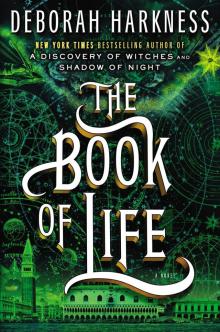 The Book of Life
The Book of Life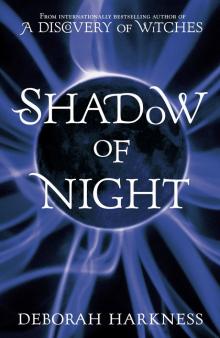 Shadow of Night
Shadow of Night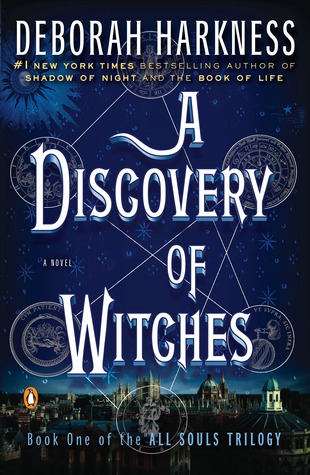 A Discovery of Witches
A Discovery of Witches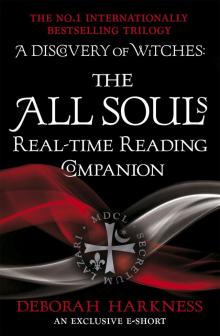 The All Souls Real-Time Reading Companion
The All Souls Real-Time Reading Companion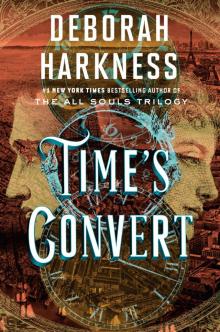 Time's Convert
Time's Convert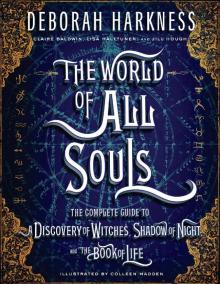 The World of All Souls
The World of All Souls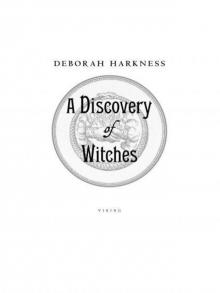 A Discovery of Witches: A Novel (All Souls Trilogy)
A Discovery of Witches: A Novel (All Souls Trilogy) Shadow of Night: A Novel
Shadow of Night: A Novel